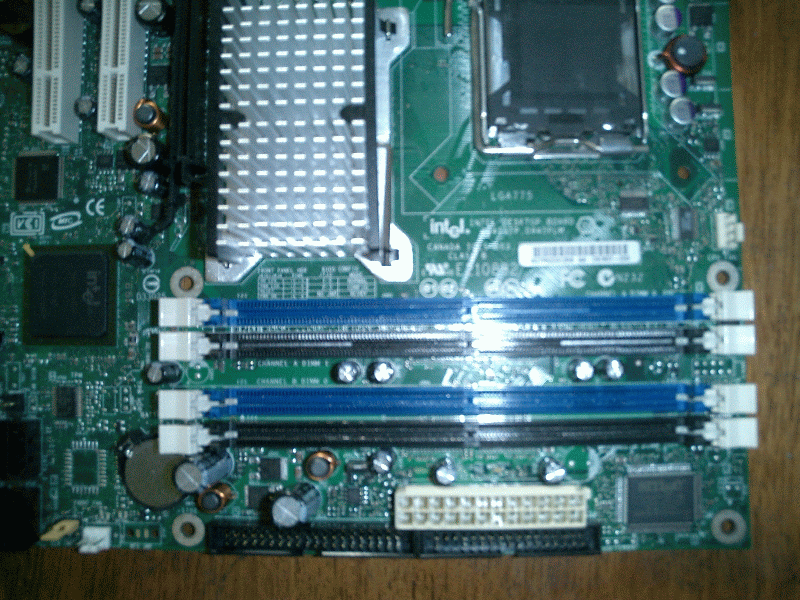Article: Intel® Desktop Board D945GTP Review (Mature for Business Segment)
III. Packaging

The box still sports the old Intel® logo, looks very professional and clearly printed with features. Users will not miss that this board is based on the newer LGA775, since the socket is imprinted on the front cover of the box. The major features of the product are clearly printed, showing the support the kind of processor, ram, audio, video card and form factor. This approach should be a really customer-friendly approach.

The back of the box gives buying customers of what the motherboard looks like without actually opening the package. This is particularly useful for those who ar ecurious as to how the motherboard looks, how the connectors are placed, how internal headers are situated, all through-out the motherboard. This portion also shows what industry regulations this particular board adheres to, such as RoHS compliance.

Opening the box reveals the offerings inside. It offers all the necessary accessories to set up the motherboard right out of the box. The accessories included are the driver CD for the chipsets, a really large Quick Reference Guide, two(2) pieces of Serial ATA cables in a beautiful flaming red color, a piece of IDE cable and FDD cable, an I/O Shield and a Configuration Label sticker.
IV. Layout

The motherboard, as it is in micro-ATX form factor, looks just about right for its form factor (i.e. square enough). As is usual with Chipzilla products targetted on the business segment, itt is bathed in no muss, no fuss, straight-colored green PCB, and still posses the marking of an old logo. A quick glance of the motherboard doesn't reveal any nagging problem, as everything is laid out nice and neat.

The upper right section, the socket area and VRM area shows no nagging problem, and has low-height capacitors. I never had problems using any of the stock cooler, but I haven't tried any after-market cooler, however, I'm quite sure that most cooler fit without any hassle. This section of the motherboard is where the 2x2 12v power connector is situated.

The upper left section is where the add-in card connectors are located. There are two(2) conventional PCI connectors, along with a newer one(1) PCI Express connector. The PCI Express x16 is also situated here in case the user needs more power graphics solution. The discrete PCie x16 is there in case there's a need for an even better graphics solution. The front-panel connector lies just above and between the PCI and PCIe x1 connector, so if you're planning to use the on-board audio-headers, and then have PCI or PCIe add-in cards, just ensure to plug the headers first for simpler integration. There is also a fan header situated here.

Just below the add-in card slots, is the Southbridge. The Southbridge has no heatsinks and lay bare. In my test, the Southbridge does heat up, though I never encountered any instability with my peripherals. Along the sides of the Southbridge chip are various on-board headers. The four(4) Serial ATA connectors are nicely grouped around here. There are also the two(2) USB headers and two(2) 1394a headers for even more I/O options. The front panel header for power switch, HDD LED, Power LED, and Reset is color-coded for ease of installation. In case of emergency, the CMOS/BIOS jumper will come in handy. There is also another fan-header here, users can mount a fancy fan on their Southbridge if needed or just use it as another header for a chassis fan. An on-board speaker is integrated in this section to give warning beeps.

The lower right section shows the four(4) DDR2 memory slots for a maximum of 4GB system memory. There's a single IDE
connector and lone standing FDD connector. The ATX24 pin connector is nicely situated along the side, to ensure a
better routing of the ATX power connectors. The hardware management chip is situated long the corner of the board.
This section is where the 4pin CPU fan header is situated, as well as that CMOS battery.
At the middle section of the board is where the Northbridge is located. It has a passive heatsink to it,
held securely by locking clips and plastic holding frame. The Northbridge heatsink is large, compared to other heatsink found on
other motherboard. During testing, the heatsink seems capable enough to handle the heat generated by the
chipset.

At the rear portion, this motherboard offers decent I/O. It still supports the old parallel printer, a serial port, an PS2-type of keyboard and mouse. This board is never lacking on the USB connectors at the back, as shown by a full four(4) USB ports, and a single 1394a connector. There's also an RJ45 connector for the Gigabit LAN, and of course for the great sounds, the audio port header is situated here. There is also a VGA connector, to utilize the chipset's on-board Intel® GMA950 graphics.


